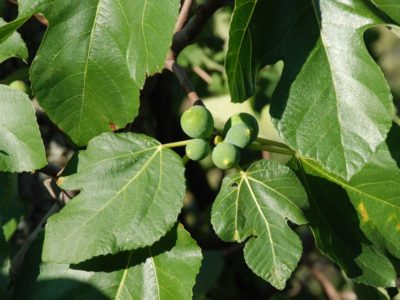
... and they sewed fig leaves together and made themselves loin coverings.
The common fig is native to the Middle East where it was already grown thousands of years ago.
If you have ever seen a picture of Adam and Eve, you probably know the fig leaf. But of course figs are better appreciated for their tasty fruits which can be eaten fresh or dried.
Names
Scientific
Ficus carica
English
Common fig
Fig
Fig tree
Dutch
Vijg
Vijgenboom
Spanish
Higuera
French
Figue
Figuier commun
German
Echte Feige
Feige
Italian
Fico
Fico comune
Taxonomy
Order
Rosales
Family
Moraceae
Genus
Ficus
Species
Ficus carica (Fig)
Basic information and facts
Origin:
South-west Asia and eastern part of the Mediterranean (Greece).
Distribution:
Figs are grown in Mediterranean countries, Iran, Pakistan, North India, some parts of the USA and Canada, Mexico, South Africa, Australia and Chili.
Evergreen or deciduous:
Deciduous
Flowers:
The flower is not visible. It blooms inside a so called “infructescence”. While it is often called a fruit, the fig is actually this infructescence, a kind of false fruit in which the flowers and seeds grow on the inside.
Leaves:
Leaves are deeply lobed with three or five lobes. They are 10 to 25 centimeter long and 10 to 18 centimeter wide.
Fruits:
Fruits are green and about 3 to 5 centimeter in diameter. When ripe the color can turn to purple.
The fruits are not real fruits, but an infructescence, which is a structure with flowers on the inside.
Climate and weather:
It grows best in a temperate or Mediterranean climate, but sometimes found in the tropics.
Pollination:
Pollination is by a specialized wasp which can enter inside the fruit to pollinate the flowers.
Height:
Shrub or small tree of 3 to 10 meter height
Spacing (close range)
Spacing (wide range)
Propagation:
Figs are usually not propagated by seeds, but by vegetative methods such as air layering.
Insect pests:
Diseases:
Fruit development:
Harvesting:
Take care when harvesting because the sap can irritate the skin.
Uses:
Fruits are eaten fresh or dried. They can also be processed to make jam.
Proverbs and Quotes
- Do men gather grapes of thorns, or figs of thistles?
- Half figs, half raisins.
- He ate one fig and he thought the autumn had come.
- If you have figs in your knapsack, everyone will want to be your friend.
- One eats figs whilst the other pays.
- Peel a fig for your friend, a peach for your enemy.
- Rather a single grape for me than a brace of figs for thee.
- Sharing figs can leave you with none at all.
- The most beautiful fig may contain a worm.
- When the figs are ripe all the birds want to eat.
- O excellent! I love long life better than figs. (William Shakespeare)
- Then the eyes of both of them were opened, and they knew that they were naked; and they sewed fig leaves together and made themselves loin coverings. (Bible: Genesis 3:7)
- He who tends the fig tree will eat its fruit, And he who
cares for his master will be honored. (New American Standard
Bible, Proverbs 27:18)
Did you know that?
- The sap of the green parts of the fig is an irritant to the skin.
- The fig fruit is actually not a real fruit but the flower of the tree.
It is a false fruit in which the flowers and seeds grow together to form a single mass,
which looks like a fruit. - In the Bible (Book of Genesis), Adam and Eve use fig leaves to cover themselves
after eating the “forbidden fruit”. - Fig fruits are rich in calcium and fiber.
- Figs can have a laxative effect.
- The fig is one of the first plants that was cultivated by humans already more
than 11,000 years ago.
Recipes
Who knows a recipe with figs?
Crop categories
Arid crops
Fruits
Major crops
Mediterranean crops
Subtropical crops
Pictures

Fig

Fig fruits

Fig fruits

Figs
